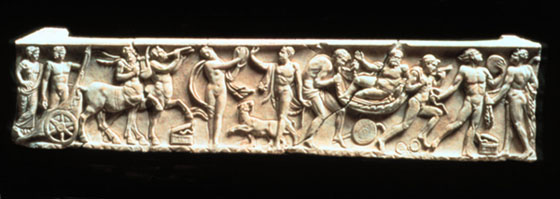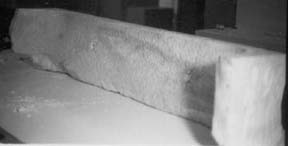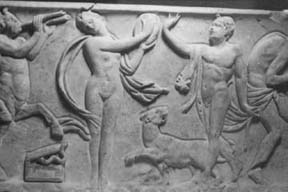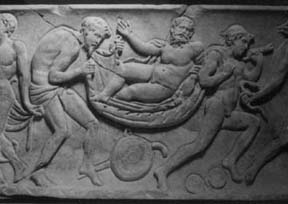
KM 81.3.1: Marble sarcophagus fragment
late 2nd Century AD
from Italy
0.41 m. high x 1.83 meters long

KM 81.3.1: Marble sarcophagus fragment
late 2nd Century AD
from Italy
0.41 m. high x 1.83 meters long
A sarcophagus (the Greek word means "flesh eater") was a stone box, or coffin, in which a body was placed for interment in Greek and Roman times. This ornately carved marble sarcophagus depicts a Bacchic procession, also known as a thiasos. This thiasos could be representative of the transition from life on earth to the afterlife. To the left, Bacchus is shown riding with his wife Ariadne in a chariot pulled by two centaurs. Each of the centaurs is playing a musical instrument - one a lyre and the other a flute. A Bacchante, or a devotee of Bacchus, is dancing naked and banging on an instrument. Another devotee of Bacchus, in the center of the scene, stands in front of Ariadne and motions to her as a panther threatens to attack. Two other Bacchantes are seen escorting Silenus, Bacchus' old and drunken tutor, while another pair are off dancing to the right. Snakes are depicted on the ground, a detail often seen in Bacchic processions.
Scenes such as this are common on sarcophagi, with the exception of the representation of Ariadne, who would more typically be shown in her own chariot riding towards Bacchus. It is also rare for her to appear fully clothed; her dignity seems to present a contrast to the naked dancing Bacchantes who surround her.
According to myth, Ariadne was a mortal who became a goddess, and in this context she is representative of hopes for a life after death. This representation might suggest the passage of Valeria Callityche from the mortal world to the afterlife.
 |
KM 81.3.1: Interior of Sarcophagus fragment |
KM 81.3.1: Detail of Bacchus and Ariadne |
 |
KM 81.3.1: Detail of Dancers, Panther?, and Snake in Basket |
 |
KM 81.3.1: Detail of Silenus and Escort |
**Please note: this "assemblage" was created solely for educational purposes. All of the objects discussed here are from entirely different archaeological contexts. A full explanation of this class project is found on the introductory page for this website.